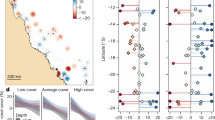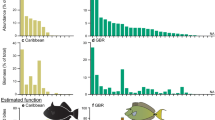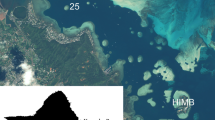Abstract
The atoll reefs of the Lakshadweep, in the Indian Ocean suffered a catastrophic mortality of hard coral in the wake of the El Niño event of 1998. This study tracked changes to coral and other benthic elements in three atolls in the Lakshadweep from 2000 to 2003. The recovery of coral was highly site-specific, and appeared to be driven by differences in post-settlement survival of coral recruits, that were in turn, influenced by the local hydrodynamics of the atolls. Post bleaching recovery was highest on west-facing reefs, while recovery on east-facing reefs was very limited. However, no ‘phase-shift’ to macroalgal dominated reefs was evident. High herbivore pressures were perhaps the most important control of macroalgae. Five years after the mass mortality, the genera that showed the maximum gains represented a mix of different susceptibilities to bleaching, while some genera that were not particularly susceptible to bleaching showed significant declines. These results suggest that decline or recovery of coral is likely dependent on individual life history strategies, post-recruitment survival, and contingency.






Similar content being viewed by others
References
Allison GW, Gaines SD, Lubchenco J, Possingham HP (2003) Ensuring persistence of marine reserves: catastrophes require adopting an insurance factor. Ecol Appl 13(1)Suppl:S8–S24
Arthur R (2000) Coral bleaching and mortality in three Indian reef regions during an El Niño southern oscillation event. Curr Sci 79:1723–1729
Arthur R (2005) Patterns and processes of reef recovery and human resource use in the Lakshadweep Islands, Indian Ocean. Ph.D. thesis, James Cook University p 135
Arthur R, Done TJ, Marsh H, Harriott VJ (2005) Benthic recovery 4 years after an ElNiño-induced coral mass mortality in the Lakshadweep atolls. Curr Sci 89:694–699
Baird A H, Marshall PA (1998) Mass bleaching of corals on the Great Barrier Reef. Coral Reefs 17:376
Bak RPM, Meesters EH (1998) Coral population structure: the hidden information of colony size-frequency distributions. Mar Ecol Prog Ser 162:301–306
Bak RPM, Meesters EH (1999) Population structure as a response of coral communities to global change. Am Zool 39:56–65
Bellwood DR, Hughes TP, Folke C, Nyström M (2004) Confronting the coral reef crisis. Nature 429:827–833
Brown BE, Downs CA, Dunne RP, Gibb SW (2002) Exploring the basis of thermotolerance in the reef coral Goniastrea aspera. Mar Ecol Prog Ser 242:119–129
Brown BE, Dunne RP, Goodson MS, Douglas AE (2000) Bleaching patterns in reef corals. Nature 404:142–143
Cheroske AG, Williams SL, Carpenter RC (2000) Effects of physical and biological disturbances on algal turfs in Kaneohe Bay, Hawaii. J Exp Mar Biol Ecol 248:1–34
Chornesky EA (1989) Repeated reversal during spatial competition between corals. Ecology 70:843–855
Clarke KR, Gorley RN (2001) PRIMER v5: User manual/tutorial. PRIMER-E, Plymouth
Clarke KR, Warwick RM. (1994) Change in marine communities: an approach to statistical analysis and interpretation. Plymouth Marine Laboratory, Plymouth
Coles SL, Brown BE (2003) Bleaching of corals on the Great Barrier Reef: differential susceptibilities among taxa. Adv Mar Biol 45:183–223
Dhargalkar VK, Shaikh N (2000) Primary productivity of marine macrophytes in the coral reef lagoon of the Kadmat Island, Lakshadweep. Curr Sci 79:1101–1104
Diaz-Pulido G, McCook LJ (2002) The fate of bleached corals: patterns and dynamics of algal recruitment. Mar Ecol Prog Ser 232:115–128
Done TJ (1992) Phase shifts in coral reef communities and their ecological significance. Hydrobiologia 247:121–132
Done TJ (1999) Coral community adaptability to environmental change at the scale of the regions, reefs and reef zones. Am Zool 39:66–79
Done TJ, Potts DC (1992) Influences of habitat and natural disturbances on contributions of massive Porites corals to reef communities. Mar Biol 114:479–493
Endean R (1976) Destruction and recovery of coral reef communities. In: Jones OA, Endean R (eds) Biology and geology of coral reefs. Academic, New York, pp 216–254
Fitt WK, Brown BE, Warner ME, Dunne RP (2001) Coral bleaching: interpretation of thermal tolerance limits and thermal thresholds in tropical corals. Coral Reefs 20:51–65
Hughes TP (1994) Catastrophes, phase shifts, and large-scale degradation of a Caribbean coral reef. Science 265:1547–1551
Hughes TP, Baird AH, Bellwood DR, Card M, Connolly SR, Folke C, Grosberg R, Hoegh-Guldberg O, Jackson JBC, Kleypas J, Lough JM, Marshall P, Nyström M, Palumbi SR, Pandolfi JM, Rosen B, Roughgarden J (2003) Climate change, human impacts, and the resilience of coral reefs. Science 301:929–933
Jompa J, McCook LJ (2003) Coral–algal competition: macroalgae with different properties have different effects on coral. Mar Ecol Prog Ser 258:87–95
Kruskal JB, Wish M (1978) Multidimensional scaling. Sage Publications, CA
Lang J, Chornesky EA (1990) Competition between scleractinian reef corals—a review of mechanisms and effects. In: Dubinsky Z (ed) Coral reefs. Elsevier, Amsterdam pp 209–252
Little AF, van Oppen MJH, Willis BL (2004) Flexibility in algal endosymbiosis shapes growth in reef corals. Science 304:1492–1494
Loya Y (1976) Recolonization of Red Sea corals affected by natural catastrophes and man-made perturbations. Ecology 57:278–289
Loya Y, Sakai K, Yamazato K, Nakano Y, Sambali H, van Woesik R (2001) Coral bleaching: the winners and the losers. Ecol Lett 4:122–131
Magurran AE (1988) Ecological diversity and its measurement. Princeton University Press, Princeton
McClanahan TR (2000) Bleaching damage and recovery potential of Maldivian coral reefs. Mar Pollut Bull 40:587–597
McClanahan TR, Baird AH, Marshall PA (2004) Comparing bleaching and mortality responses of hard corals between southern Kenya and the Great Barrier Reef, Australia. Mar Pollut Bull 48:327–335
McClanahan TR, Maina J, Pet-Soede L (2002) Effects of the 1998 coral mortality event on Kenyan coral reefs and fisheries. Ambio 31:543–550
McCook LJ, Jompa J, Diaz-Pulido G (2001) Competition between corals and algae on coral reefs: a review of evidence and mechanisms. Coral Reefs 19:400–417
McManus JW, Polsenberg JF (2004) Coral–algal phase shifts on coral reef: ecological and environmental aspects. Prog Oceanogr 60:263–279
Mumby PJ (1999) Bleaching and hurricane disturbances to populations of coral recruits in Belize. Mar Ecol Prog Ser 190:27–35
Nyström M, Folke C, Moberg F (2000) Coral reef disturbance and resilience in a human-dominated environment. Trends Ecol Evol 15:413–417
Obura DO (2001) Can differential bleaching and mortality among coral species offer useful indicators for assessment and management of reefs under stress? Bull Mar Sci 69:421–442
Pearson RG (1981) Recovery and recolonization of coral reefs. Mar Ecol Prog Ser 4:122
Sammarco PW, Levinton JS, Ogden JC (1974) Grazing and control of coral reef community structure by Diadema antillarum philippi (Echinodermata: Echinoidea): a preliminary study. J Mar Res 32:47–53
Sheppard CRC (2003) Predicted recurrences of mass coral mortality in the Indian Ocean. Nature 425:294–297
Sheppard CRC, Spalding M, Bradshaw C, Wilson S (2002) Erosion versus recovery of coral reefs after 1998 El Niño Chagos Reefs, Indian Ocean. Ambio 31:40–48
Sokal RR, Rohlf FJ (1981) Biometry: the principles and practice of statistics in biological research. W H Freeman, New York
Steneck R (1986) The ecology of coralline algal crusts: convergent patterns and adaptive strategies. Annu Rev Ecol Syst 17:273–303
Steneck R, Dethier MN (1994) A functional group approach to the structure of algal-dominated communities. Oikos 69:476–498
Tomasik T, van Woesik R, Mah A (1996) Rapid coral colonization of a recent lava flow following a volcanic eruption, Banda Islands, Indonesia. Coral Reefs 15:169–175
Wafar MVM (1986) Corals and coral reefs of India. Proc of Indian Acad Sci Anim Sci/Plant Sci (Suppl):19–43
Wilkinson CR (1998) Status of the coral reefs of the world. Australian Institute of Marine Science, Townsville
Acknowledgments
This study was supported by the Diversitas/Total Foundation. We thank the Lakshadweep Administration and the Department of Science and Technology for permissions, Lacadives Dive School for logistic support, and everyone at TESAG for administrative support. For field assistance, reviewing manuscripts, and other support, we are grateful to MK Ibrahim, Shah Jahan, Teresa Alcoverro, Nuria Marba, MD Madhusudan, Graeme Inglis, TR Shankar Raman, Paul Marshall, Charudutt Mishra, Simone Mariani, Ameer Abdullah, Oliver Floerl, Divya Mudappa, Joshua Cinner, Nadine Marshall, Anindya Sinha, Peter Mumby and two anonymous referees.
Author information
Authors and Affiliations
Corresponding author
Additional information
Communicated by Ecology Editor P.J. Mumby
Vicki Harriott: deceased
Rights and permissions
About this article
Cite this article
Arthur, R., Done, T.J., Marsh, H. et al. Local processes strongly influence post-bleaching benthic recovery in the Lakshadweep Islands. Coral Reefs 25, 427–440 (2006). https://doi.org/10.1007/s00338-006-0127-4
Received:
Accepted:
Published:
Issue Date:
DOI: https://doi.org/10.1007/s00338-006-0127-4




